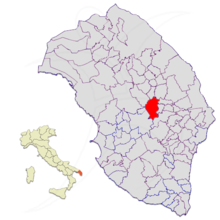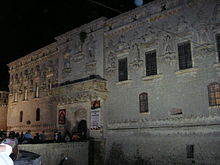Corigliano d'Otranto
| Corigliano d'Otranto | ||
|---|---|---|

|
|
|
| Country | Italy | |
| region | Apulia | |
| province | Lecce (LE) | |
| Coordinates | 40 ° 10 ′ N , 18 ° 15 ′ E | |
| height | 76 m slm | |
| surface | 28 km² | |
| Residents | 5,719 (Dec 31, 2019) | |
| Population density | 204 inhabitants / km² | |
| Post Code | 73022 | |
| prefix | 0836 | |
| ISTAT number | 075023 | |
| Popular name | Coriglianesi or chorianì (in griko ) | |
| Patron saint | San Nicola di Mira | |
| Website | Corigliano d'Otranto | |
Corigliano d'Otranto is a municipality in southern Italy .
geography
topography
It has 5719 inhabitants (as of December 31, 2019). Corigliano d'Otranto is located in the province of Lecce in the Apulia region , in the central part of the lower Salentine peninsula and about 25 km south of the provincial capital Lecce . The district area of 28 km² is at heights between 73 and 109 m above sea level .
The municipal boundaries are in the north with the municipalities of Soleto , Zollino and Martano , in the east with the municipalities of Castrignano de 'Greci and Melpignano , in the south with the municipalities of Maglie and Cutrofiano , and in the west with the municipalities of Sogliano Cavour and Galatina .
The area around Corigliano is mainly built with olive groves . In addition, oaks and pines grow here .
Cultural geography
The village is part of the Grecìa Salentina , a linguistic island in which an archaic neo-Greek dialect with ancient and middle Greek and Latin elements is spoken, also called Griko or "Greco". In this idiom the city is called Choriàna or Koriàna . In the Salentine dialect, however, the name of the city is Curiànu .
climate
The closest weather station is in Lecce Galatina . The climate of Corigliano d'Otranto is typically Mediterranean , but with continental peaks. The meteorological data show that the winters are not very cold; however, frosts can often occur in January and February . Summers are hot, humid and extremely dry. Precipitation is concentrated in autumn and winter and averages 639 mm annually.
history
development
The remains of a specchia in the localities of Serra and Murica testify that Corigliano was the home of a prehistoric culture . The origins of Corigliano d'Otranto are not certain, but the town was certainly built in ancient times . A temple dedicated to the goddess Vesta dates from the Roman period . The spatial planning structure of the old town between Via Capiterra and Via Cavour also consists of lots that are based on the Roman Actus . Important for the development of Corigliano was the Basilian monastery of St. George, called Sinòdia , from the 9th century . The monastery school taught the Greek language and Eastern Roman culture and left numerous Greek codices . The first historical evidence dates back to 1192, when King Tankred of Sicily gave the area to Pietro Indini as a fief. The monastery of St. George fell into disrepair in the 16th century as a result of the destruction of the monastery of San Nicola di Casole in Otranto , on which it was dependent.
Place name
The name of the village is erroneously derived from the word cuore (heart) , also in the local coat of arms. According to another theory, the name of the city derives from a hypothetical centurion Corelius , who is said to have been allocated the territory after the Roman conquest. It is more likely, however, that the name was formed from the Middle Greek term χωρίον (choríon) for “settlement” or “village”, later the name Corigliano was formed through alteration.
traffic
The railway station of Corigliano d'Otranto is situated on the railway line Zollino Gagliano-Leuca .
Monuments and landmarks
San Nicola, the Chiesa Madre of Corigliano d'Otranto, is located directly at the northern end of Via Chiesa, where one of the ancient access gates to the city used to open, in the local Greek dialect "Upper door" or Anuporta (from the Greek Ἀνωπόρτα ) and not far from the bell tower that is aligned with the church facade. This was built in the years 1467–68, as can be seen from the year engraved in Greek numerals on the window of the 2nd order . Originally the tower inserted into the medieval city walls served as a watchtower . The lions on the four corners of the frame of the 2nd order of the tower as well as the three-part arches of the cornice , the leaf-shaped decorations and all other decorative elements of the facade are typically medieval . The conversion of the watchtower to a bell tower can best be seen in the height of the last order, where the central supports of the biforas were subsequently removed to make room for the bells .
The Chiesa Madre was built in 1622 on the site of a previously existing sacred building, some parts of which have been preserved, such as the entrance portal dated 1573 with the statues of the Redeemer , the Mother of God and the patron saint Nicholas of Myra . The building is built in the shape of a Latin cross with the apse facing east . It is characterized by a considerable overall height, the impression of which is reinforced by the solidity of the columns supporting the cover of the central nave and the geometry of the vaulted vault, which was built in the Lecce style . Over the centuries the church has undergone numerous transformations, one of the more important of which was the floor mosaic in 1878. Similar to the model of the Cathedral of Otranto , it depicts the motif of the tree of life with its various biblical scenes. Recent repair work on the ground has brought to light an underground cemetery .
Web links
Individual evidence
- ↑ Statistiche demografiche ISTAT. Monthly population statistics of the Istituto Nazionale di Statistica , as of December 31 of 2019.
- ^ Don Mauro Cassoni: Griko-Italiano, Vocabolario. Lecce 1999
- ↑ Angelo Campa-Vincenzo Peluso: Guida di Corigliano; Tra le case e la fortezza nella Grecìa Salentina. Galatina 1999.





